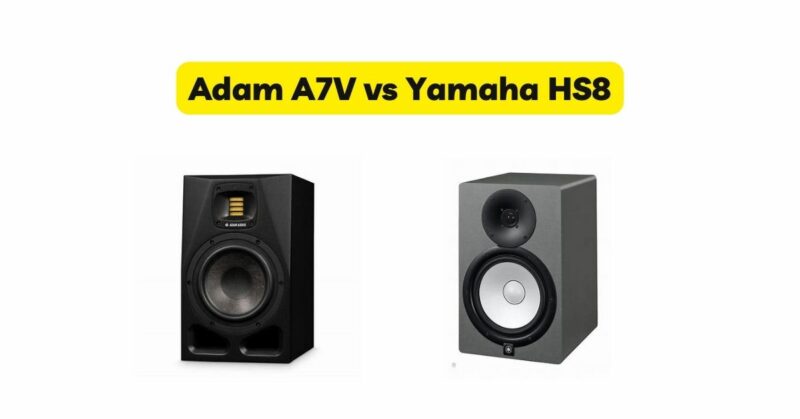Studio monitors play a crucial role in accurate audio monitoring and critical listening during music production, mixing, and mastering. In this detailed comparison, we will examine two popular studio monitor models: the Adam A7X and the Yamaha HS8. These monitors are highly regarded for their sound quality, build construction, and performance. By analyzing their design, sound characteristics, features, and overall value, we aim to help you make an informed decision when choosing between the Adam A7X and the Yamaha HS8 for your studio setup.
Design and Build Quality
The Adam A7X and the Yamaha HS8 differ in design philosophy and build construction, offering unique aesthetics and functional attributes.The Adam A7X features a sleek and modern design with rounded edges and a distinctive yellow woofer cone. Its 7-inch carbon fiber/rohacell/glass fiber midwoofer delivers tight and controlled bass, while the X-ART tweeter reproduces high frequencies with exceptional detail and accuracy. The A7X’s front-firing bass reflex port enhances low-end response and allows for flexible placement options in the studio. The cabinet is well-constructed using high-quality materials, ensuring rigidity and minimizing unwanted resonances for transparent and accurate sound reproduction.In contrast, the Yamaha HS8 follows a more understated design approach with a classic rectangular shape and a black or white finish. It features an 8-inch woofer that produces deep and precise bass response, along with a 1-inch dome tweeter for clear and detailed high-frequency reproduction. The HS8’s rear-firing port optimizes low-frequency performance and minimizes turbulence. Yamaha has designed the cabinet with a focus on reducing resonance and vibration, resulting in a solid and reliable build that contributes to the monitor’s overall accuracy.
Sound Performance
The sound performance of the Adam A7X and the Yamaha HS8 reflects their respective design choices, driver technology, and engineering expertise.The Adam A7X delivers a balanced and articulate sound signature across the frequency spectrum. Its carbon fiber/rohacell/glass fiber midwoofer provides punchy and well-controlled bass, while the X-ART tweeter delivers extended high-frequency response with exceptional clarity and detail. The A7X offers a wide and detailed soundstage, allowing for precise imaging and instrument placement. Its transparent and accurate sound reproduction makes it an ideal choice for critical listening, mixing, and mastering applications.The Yamaha HS8 is known for its accuracy and neutrality, delivering a flat frequency response that allows for honest monitoring. The 8-inch woofer provides a powerful and extended low-end response, ideal for tracking bass-heavy genres or working with sub-bass frequencies. The 1-inch dome tweeter reproduces high frequencies with precision and clarity. The HS8’s sound signature is characterized by its clear midrange, detailed highs, and well-defined low end. Its reliable and consistent performance makes it suitable for a wide range of studio applications.
Features and Connectivity
Both the Adam A7X and the Yamaha HS8 offer features and connectivity options that enhance their versatility and usability in studio environments.The Adam A7X provides balanced XLR and unbalanced RCA inputs, ensuring compatibility with various audio interfaces and equipment. It also includes a front-panel power switch and volume control for easy access and adjustment. Additionally, the A7X features a tweeter gain control that allows for fine-tuning of the high-frequency response according to the room’s acoustic characteristics. The rear-panel offers room compensation switches to adapt the monitor’s performance to different acoustic environments.The Yamaha HS8 features balanced XLR and TRS inputs, enabling connection to professional audio interfaces and mixing consoles. It includes level control and room control switches on the rear panel, allowing for customization of the monitor’s response based on room acoustics. The HS8 also offers a high-trim switch to adjust the high-frequency level, ensuring compatibility with different listening preferences and room configurations.
Value and Price
The Adam A7X and the Yamaha HS8 differ in terms of pricing, with the A7X generally being priced higher than the HS8. The price variation reflects the differences in driver size, design intricacies, and overall sound performance.The Adam A7X’s superior build quality, detailed sound reproduction, and extended frequency response justify its higher price point. It is a preferred choice for professionals and enthusiasts who require uncompromising accuracy and sonic excellence in their studio monitoring.The Yamaha HS8, with its reliable performance, solid build construction, and competitive price, offers excellent value for budget-conscious users. It provides accurate monitoring capabilities suitable for a wide range of studio applications and is a popular choice among beginner to intermediate level producers, engineers, and musicians.
Conclusion
In conclusion, the Adam A7X and the Yamaha HS8 are both highly capable studio monitors that excel in different areas. The A7X impresses with its detailed sound reproduction, wide soundstage, and transparent imaging, making it a preferred choice for critical listening and professional studio environments. On the other hand, the HS8 offers reliable and accurate monitoring with its flat frequency response, powerful bass response, and versatile connectivity options, catering to a wide range of studio applications.When deciding between the Adam A7X and the Yamaha HS8, consider factors such as your budget, desired sound characteristics, room size, and intended applications. Both monitors offer exceptional performance and build quality, ensuring accurate audio monitoring during music production, mixing, and mastering. Ultimately, your choice should align with your specific needs, preferences, and budget, allowing you to create and enjoy high-quality sound reproduction in your studio setup.


